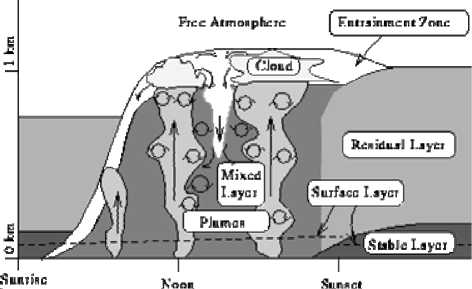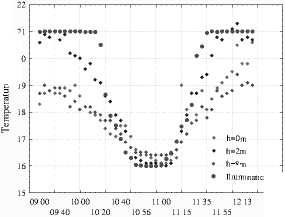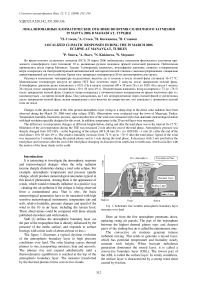Localized climatic responses during the 29 march 2006 eclipse at Manavgat, Turkey
Автор: Stoeva P., Stoev A., Kiskinova N., Stoyanov N.
Журнал: Солнечно-земная физика @solnechno-zemnaya-fizika
Статья в выпуске: 12 т.2, 2008 года.
Бесплатный доступ
Changes in the physical state of the 10m ground atmospheric layer owing to a sharp drop in the direct solar radiation have been observed during the March 29, 2006 total solar eclipse (TSE). Observations were conducted near the town of Manavgat, Turkey. Temperature, humidity, barometric pressure, speed and direction of the wind were measured with a fast automatic meteorological station with high resolution specially designed for this event. In addition, temperature in the 20 cm soil layer were measured. The difference in temperature changes at different heights before, during and after the total phase was in the interval 16-17 °C. Minimum of the air temperature during the TSE was measured 2 min after the end of the total phase. Atmospheric pressure was sharply changed from 1021 hPa - at the beginning of the eclipse (09 h 38 min 28 s ) to 1028 hPa - 1 min 26 s after the end of the total phase (10 h 58 min 49 s). The relative humidity increases from 72 % up to -76 % after the total phase. Speed of the wind was measured in 5 minutes during the partial phases and in 1 min during the total phase. It decreases with 3 m/s just before the total phase and increases after the end of the total phase changing its direction from south-east to north-east, which coincides with the motion of the lunar shade on the earth.
Короткий адрес: https://sciup.org/142103275
IDR: 142103275 | УДК: 523.9.528.342,
Текст научной статьи Localized climatic responses during the 29 march 2006 eclipse at Manavgat, Turkey
It is interesting to investigate the atmospheric response and meteorological changes when the solar radiation income sharply diminishes during a total solar eclipse. For example, atmospheric temperature and pressure rapidly change, which produce meteorological anomalies typical in this kind of phenomena. Among them is the appearance of winds, which would eventually influence in a positive way - cleaning the air pollution if the eclipse is being observed from a contaminated area. That is why, the basic meteorological parameters have to be measured with high sensitive meteorological instruments: temperature (air and soil), relative humidity, pressure changes and speed of the wind in the 10 m air layer, including the terrain level. These observations could be compared with those already published elsewhere and with models.
Stull [1] defines the atmospheric boundary layer «as the part of the troposphere that is directly influenced by the presence of the earths surface, and responds to surface forcings with a time scale of about an hour or less.»
The figure 1 illustrates a typical daytime evolution of the atmospheric boundary layer in high pressure conditions over land. The solar heating causes thermal plumes to rise, transporting moisture, heat and aerosols. The plumes rise and expand adiabatically until a thermodynamic equilibrium is reached at the top of the atmospheric boundary layer. The moisture transferred by the thermal plumes forms convective clouds.

Fig. 1. Schematic fair-weather atmospheric boundary layer structure over land.
Drier air from the free atmosphere penetrates down, replacing rising air parcels. The part of the troposphere between the highest thermal plume tops and deepest parts of the sinking free air is called the entrainment zone.
The convective air motions generate intense turbulent mixing. This tends to generate a mixed layer, which has potential temperature and humidity nearly constant with height. When buoyant turbulence generation dominates the mixed layer, it is called a convective boundary layer (CBL). The lowest part of the ABL is called the surface layer. In windy conditions, the surface layer is characterized by a strong wind shear caused by friction.
The boundary layer from sunset to sunrise is called the nocturnal boundary layer. It is often characterized by a stable layer, which forms when the solar heating ends and the radiative cooling and surface friction stabilize the lowest part of the ABL. Above that, the remnants of the daytime CBL form a residual layer. The nocturnal boundary layer may also be convective when cold air advects over a warm surface.
Under high pressure, divergence of air masses shallows the boundary layer. Typically, only fairweather cumulus clouds are present. The analysis of the boundary layer structure is not usually that straightforward in the case of low pressure. The air parcels converge in low pressure in connection with updrafts, which transfer boundary layer air parcels high above the ground. The clouds may then grow to the top of the troposphere. This leads to extensive variations in the local boundary layer top. Thus, it becomes difficult to define a larger scale boundary layer depth.
We observed the eclipse and conducted our experiments from Manavgat, near Antalya (see the map), together with our colleagues from Kandilli Observatory, Istambul, because it is one of the sunniest places in Turkey – the percent of possible sunshine is 60 %. Full phase of the eclipse begins at 10 h 55 min 57 s 10:56 UT and its full duration is 3 min 46 s [2].
Observations
Micrometeorological parameters during the March 29, 2006 total solar eclipse were measured with an automatic meteorological station in the 10 m air layer in contrast to measurements conducted in the 2 m air layer during the 1999 total solar eclipse [3]. Continuous measuring of temperature (air and soil), relative humidity, pressure changes and speed of the wind, including the terrain level was conducted.
Strictly speaking, a comparisons between microclimatic parameters during different eclipses can not be done because of the substantial difference between the local relief, altitude, the albedo of the specific land type, geographic position and moment of the total phase. Variations in thermal response are more closely related to the albedo of the particular land type than to other factors. When typical albedo differences are not significant between two lands characteristics other than albedo (turbulence and wind direction) are most likely controlling the timing of the temperature minima. During the 2006 TSE, minimal temperature (Tmin) is measured 2 min after the total phase, and for the 1999 TSE – 7 min 30 s. It is in accordance with the fact that the temperature minima at residential/ commercial stations occurred in general, before the minima at stations in agricultural/golf terrains [4]. In 2006 we were at the yard of the hotel, and in 1999 in the countrycide.
Temperature
The fall of temperature during this eclipse was clearly defined (Fig. 2).
Temperatures started to fall from 21 ° C shortly after the first contact and reached a minimum of 16 ° C two minutes after the end of totality or maximum eclipse (UT=11:01). The difference in temperature changes at different heights before, during and after the total phase was in the interval 16-16.5 ° C. The recovery of temperature was then quite rapid with pre-eclipse values reached at 11:45.
Air temperature at different heights andthe Illumination

h=8ir.
Illumination
Universal Time, hh:mm
Fig. 2. Dynamics of the temperature and illumination during the total Solar eclipse on March 29, 2006.

Illumination
Variations of the sky zenith illumination during the eclipse were measured with the help of a luxmeter LUX-PU-150. Decreasing of the illumination was generally gradual in the early stages following the first contact, but was rapid around totality. The graph shows that the first significant decreasing occurred around 10:25, that is to say 47 minutes after the first contact and reached a minimum at maximum eclipse (10:58). Recovery of illumination levels was then rapid. This decreasing of the illumination caused a significant sharpening of shadows and had resulted in fooling local songbirds into an evening chorus as in past eclipses [5].
Atmospheric pressure
Atmospheric pressure changed sharply from 1021 hPa – in the phase immediately following the first contact (09 h 38 min 28 s ) to 1028 hPa – 1 min 26 s after the end of the total phase (10 h 58 min 49 s).
Relative humidity
During an eclipse the relative humidity is expected to increase for two reasons. Firstly, cooling air approaches saturation, and secondly the water vapour pressure increases due to evaporation causing the relative humidity to increase. Relative humidity increased from 72 % up to ~76 % after the total phase as usual in phenomena like this [6].
Winds
The drop in wind speed on the approach of maximum eclipse is also well documented and tends to be as marked as the reduction in temperature. The time of maximum eclipse tends to be marked by a lull. There is often a change in wind direction. Speed of the wind was measured in 5 minutes during the partial phases and in 1 min during the total phase. It decreased to 3 m/s just before the total phase and increases after the end of the total phase changing its direction from south-east to north-east, which coincides with the motion of the lunar shade on the earth. Such large increases in wind velocity are termed eclipse 'gust fronts' and occur roughly 40–50 minutes before and after totality or maximum eclipse.
Cloudiness
Cirrus and cirrostratus clouds were observed during the total solar eclipse. The progressive increase in higher level cloud during an eclipse is well documented and is believed to be caused by cooling of moist layers of the atmosphere at height as the lunar shadow approaches.
П . Стоева , A. Стоев , Н . Кискинова , Н . Стоянов
Ackowledgements
The authors express their special thanks to Dipl. Eng. Evgenij Hristov for his cooperation in preparing and tuning up of the automatic meteorological station, and to amateur astronomers from the astroclub «Gemma», Stara Zagora for their help during the expedition.


